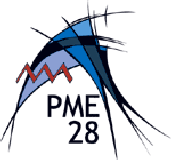


PME28 Bergen, Norway 14–18 July 2004
The 28th International Conference of the International Group for the Psychology of Mathematics Education
Research Reports
A
B
C
D
E
F
G
H
I
J
K
L
M
N
O
P
Q
R
S
T
U
V
W
X
Y
Z
A B C D E F G H I J K L M N O P Q R S T U V W Y Z © 2004 PME28 Conference Secretariat, Landåssvingen 15, 5096 Bergen, Norway
Alatorre, SilviaProportional reasoning of quasi-illiterate adults
Alcock, LaraUses of example objects in proving
Amato, SolangeImproving student teachers’ attitudes to mathematics
Amit, MiriamTime and Flow as Parameters in International Comparisons: A View from an Eighth Grade Algebra Lesson
Anghileri, JuliaDisciplined Calculators or Flexible Problem Solvers?
Antonini, SamueleA Statement, the contrapositive and the inverse: intuition and argumentation
Arnon, IlanaSolution - what does it mean? Helping linear algebra students develop the concept while improving research tools
Asghari, Amir HosseinOrganizing with a focus on defining, a phenomenographic approach
Askew, MikeMediation and interpretation: exploring the interpersonal and the intrapersonal in primary mathematics lessons
Axiak, CettinaBeing Sensetive to Students Mathematical Needs: What does it take?
Baturo, AnnetteEmpowering Andrea to Help Year 5 Students COnstruct Fraction Understanding
Bayazit, IbrahimUnderstanding Inverse Functions: The Relationship Between Teaching Practice and Student Learning
Beswick, KimThe impact of teachers' perceptions of student characteristics on the enactment of their beliefs
Bikner-Ahsbahs, towards the emergence of constructing mathematical meanings
Bingolbali, ErhanIdentity, knowledge and departmental practices: Mathematics of engineers and mathematicians.
Blanton, MariaElementary students' capacity for functional thinking
Bobis, JanetteFor the sake of the children: Maintaining the momentum of a professional development program
Boufi, AdaFrom formal to semi-informal algorithms: The passage of a classroom into a new mathematical reality
Bragg, PhilippaA Measure of Rulers- The Importance of Units in a Measure
Breen, ChrisIn the Serpent's Den: Contrasting scripts relating to fear of mathematics
Callingham, RosemaryPrimary students' understanding of tessellation: An initial exploration
Chapman, OliveFacilitating Peer Interactions in Learning Mathematics: Teachers' Practical Knowledge
Charalambous, Towards a unified model on teachers´concerns and efficacy beliefs related to a mathematics reform
Chick, HelenWhat is unusual? The case of a media graph
Christou, ConstantinosProofs through exploration in dynamic geometry environments
Clark, KarenEstablishing a proessional learning community among middle school mathematics teachers
Clarke, DavidPatterns of Participation in the Mathematics Classroom
Cooper, TomYoung White Teachers' Perceptions of Mathematics Learning of Aboriginal and Non-Aboriginal Students in Remote Communities
Cortes, AnibalTwo Important Invariant Tasks in Solving Equations: Analyzing the Equation and Checking the Validity of Transformations
Deloustal-Jorrand, Virginiestudying the mathematical concept of implication through a problem on written proofs
Di Martino, PietroFrom single beliefs to belief systems: a new observational tool
Doig, BrianAssessment as a strategic tool for enhancing learning in teacher education: a case study
Domingo, PaolaPatterns of reasoning in classroom
Dougherty, BarbaraGeneralized diagrams as a tool for young children’s problem solving
Downs, MartinCorrespondences, Functions and Assignation Rules.
Dvora, TaliUnjustified assumptions based on diagrams in geometry
Elia, IliadaThe functions of pictures in problem solving
English, LynMathematical Modelling with Young Children
Esteley, CristinaExtending linear models to non-linear contexts: an in-depth study about two university students' mathematical productions
Evangelidou, AnastasiaUniversity students’ conceptions of function
Falcade, RossanaTowards a definition of function
Ferrara, Francesca“why doesn’t it start from the origin?”: hearing the cognitive voice of signs
Ferrari, Pier LuigiMatematical language and advanced mathematics learning
Filloy, EugenioArithmetic/algebraic problem-solving and the representation of two unknown quantities
Forgasz, HelenEquity and computers for mathematics learning:Access and equity
Frade, CristinaThe tacit-explicit dynamic in learning processes
Freiman, ViktorTracking primary students' understanding of the equal sign
Friedlander, AlexLevels of Student Responses in a Spreadsheet-Based Environment
Fritzlar, TorstenSensitivity for the complexity of problem ori-ented mathematics instruction – a challenge to teacher education
Fuglestad, Anne BeritICT tools and students' competence development
Giraldo, VictorDescriptions and conflicts in dynamic geometry
Glass, BarbaraStudents problem solving and justification
Gómez, PedroDidactical knowledge development of pre-service secondary mathematics teachers
González-Martín, Legitimization of the graphic register in problem solving at the undergraduate level. The case of the improper integral.
Gorev, DvoraWill “The way they teach” be “The way they have learned”? Pre-service teachers’ beliefs concerning computer embedding in math teaching.
Groves, SusieProgressive discourse in mathematics classes ? The task of the teacher
Guimarães, Luiz CarlosTeacher's Practices and Dynamic Geometry
Gutierrez, AngelCharacterization of students’ reasoning and proof abilities in 3-dimensional geometry
Halverscheid, StefanOn motivational aspects of instructor-learner interactions in extra-curriculum activities
Hannula, MarkkuDevelopment of understanding and self-confidence in mathematics grades 5–8
Harel, GuershonMathematics Teachers' Knowledge Base: Preliminary Results
Healy, LuluThe role of tool and teacher mediations in the construction of meanings for reflection
Heinze, AisoThe Proving Process in Mathematics Classroom - Method and Results of a Video Study
Hoch, MaureenStructure sense in high school algebra: the effect of brackets
Hopkins, SarahExplaining variability in retrieval times for addition produced by students with mathematical learning difficulties
Horne, MarjEarly Gender Differences
Hähkiöniemi, MarkusPerceptual and symbolic representations as a starting point of the acquisition of the derivative
Inglis, MatthewMathematicians and the Selection Task
Johnsen-Høines, MaritTextual differences as conditions for learning processes
Kalyanasundaram, Teaching arithmetic and algebraic expressions
Kaput, JamesAn introduction to the profound potential of connected algebra activities: issues of representation, engagement and pedagogy
Karaagaç, Mehmet The tension between teacher beliefs and teacher practice: The impact of the work setting.
Kelleher, HeatherWhat a simple task can show: teachers explore the complexity of children?S thinking
Kidron, IvyConstructing knowledge about the bifurcation diagram: epistemic actions and parallel constructions
Knoll, EvaExperiencing research practice in pure mathematics in a teacher training context
Kramarski, BrachaEnhancing mathematical literacy with the use of metacognitive guidance in forum discussion
Lavy, IlanaKinds of arguments emerging while exploring on a computerized environment
Lawrie, ChristineUsing Solo to analyse group responses
Ledesma Ruiz, Elena Connections between qualitative and quantitative thinking about proportion: The case of Paulina.
Leikin, RozaTowards high quality geometrical tasks: reformulation of a proof problem
Leron, UriMathematical thinking and human nature: consonance and conflict
Leu, Yuh-ChynThe mathematics pedagogical values delivered by an elementary teacher in her mathematics instruction: Attainment of Higher Education and Achievement
Leung, AllenVisual reasoning in computational environment: a case of graph sketching
Levenson, EstherElementary school students' use of mathematically-based and practically-based explanations: The case of multiplication
Liljedahl, PeterMathematical Discovery: Hadamard Resurected
Lin, Pi-JenSupporting Teachers on Designing problem-Posing Tasks as a Tool of Assesment to Understand Students' Mathematical Learning
Lo, Jane-JaneProspective elementary school teachers¡¦ solution strategies and reasoning for a missing value proportion task
Mcclain, KayThe critical role of institutional context in teacher development
Mcdonough, AndreaStudents' perceptions of factors contributing to successful participation in mathematics
Merenluoto, KaarinaThe cognitive-motivational profiles of students dealing with decimal numbers and fractions
Michaelidou, NikiThe number line as a representation of decimal numbers: A research with sixth grade students
Middleton, JamesPreservice teachers conceptions of mathematics-based software
Misailidou, ChristinaHelping children to model proportionally in group argumentation: overcoming the ‘constant sum’ error
Mitchelmore, MichaelAbstraction in mathematics and mathematics learning
Miyakawa, TakeshiReflective Symmetry in Construction and Proving
Modestou, ModestinaStudents' improper proportional reasoning: The case of area and volume of rectangular figures
Monaghan, JohnAbstraction and consolidation
Monteiro, CarlosCritical sense in interpretations of media graphs
Morselli, FrancescaBetween affect and cognition: Proving at University level
Mousley, JudithAn aspect of mathematical understanding: The notion of "Connected knowing"
Mousoulides, NikosAlgebraic and Geometric Approach in Function Problem Solving
Mulligan, JoanneChildren's development of structure in early mathematics
Neria, DoritStudents preference of non-algebraic representations in mathematical communication
Nicol, CynthiaLearning to see in mathematics classrooms
Nilsson, PerStudents`ways of interpreting aspects of chance embedded in a dice game.
Nisbet, StevenThe impact of state-wide numeracy testing on the teaching of mathematics in primary schools
Noyes, Andy"The poetry of the universe”: new mathematics teachers’ metaphoric meaning-making
Nunokawa, KazuhikoWhat studnets do when hearing ohters explaining
Outhred, LynneStudents' structuring of rectangular arrays
Ouvrier-Buffet, CecileConstruction of mathematical definitions: an epistemological and didactical study
Ozmantar, Mehmet FatihMathematical Abstraction through Scaffolding
Paparistodemou, EfiDesigning for local and global meanings of randomness
Paschos, TheodorusIntegrating the history of mathematics in educational praxis. An euclidean geometry approach to the solution of motion problems
Pehkonen, LeilaThe Magic Circle of the Textbooks an Option or an Obstacle for Teacher Change
Peled, IritSituated or abstract: the effect of combining context and structure on constructing an additive (part-part-whole) schema
Peretz, DvoraUsing graphical profiles to study the learning and teaching of mathematics
Person, AxelleThe Role of Number in Proportional Reasoning: A Prospective Teacher's Understanding
Pierce, RobynLearning to use cas:voices from a classroom
Pinto, MarciaTechnical School Studentsïconceptions on tangent lines
Pitta-Pantazi, DemetraElementary school students' mental representations of fractions
Pittalis, MariosA structural model for problem posing
Povey, HilarySome undergraduates' experience of learning mathematics
Psycharis, GiorgosNormalising geometrical constructions: a context for the generation of meanings for ratio and proportion
Rivera, FerdinandA Sociocultural Account of Students' Collective Mathematical Understanding of Polynomial Inequalities in Instrumented Activity
Robutti, OrnellaInfinity as a multi-faceted concept in history and in the mathematics classroom
Rodd, MelissaSuccessful Undergraduate Mathematicians: a study of students in two universites
Rolka, KatrinBilingual lessons and mathematical world views - a German perspective
Ron, GilaThe use of models in teaching proof by mathematical induction
Rowland, TimReflecting on prospective elementary teachers’ mathematics content knowledge: the case of Laura.
Rubio, GuillermoThe competent use of the analytic method in the solution of algebraic word problems. A didactical model based on a numerical approach with junior high students
Rønning, FrodeLanguage and Concept Development in Geometry
Safuanov, IldarPsychological aspects of genetic approach to teaching mathematics
Schlöglmann, WolfgangRoutines in non-routine problem solving processes
Schwarz, BaruchTeacher Guidance of Knowledge Construction
Shaughnessy, J. MichaelTypes of Student Reasoning on Sampling Tasks
Shternberg, Beba (buzina)Didactic Model - Bridging a Concept with Phenomena
Siemon, DianneElaborating the teacher's role - Towards a professional language
Simpson, AdrianMaking The Connection: Procedural And Conceptual Students’ Use Of Linking Words In Solving Problems
Slovin, HannahChildren’s conceptual understanding of counting
Spinillo, Alina GalvãoAdding fractions using ´half´as an anchor for reasoning
Stacey, KayePersistence of decimal misconceptions and readiness to move to expertise
Stehliková, NadaMolly and equeations in A2: A case study of apprehending structure
Straesser, RudolfImage - metaphor - diagram: visualisation in learning mathematics
Sulista, MarekImages of fractions as processes and images of fractions in processes
Sullivan, PeterDescribing elements of mathematics lessons that accommodate diversity in student background
Sutherland, RosOrchestrating mathematical proof through the use of digital tools
Sztajn, PaolaSchool-based community of teachers and outcomes for students
Tatsis, KonstantinosThe effect of students' roles on the establishment of shared meanings during problem solving
Thomas, MikeIntegrating CAS Calculators Into Mathematics Learning: Partnership Issues
Thomas, NoelThe development of structure in the number system
Thornton, StephenOrientations to numeracy: Teachers confidence and disposition to use mathematics across the curriculum
Torbeyns, JokeEfficiency and adaptiveness of multiple school-taught strategies in the domain of simple addition
Tsai, Wen-HuanSupporting Teachers on Developing Teaching Norms Based on Children's Learning Mathematics
Tsamir, PessiaProspective teachers images and definitions: The case of inflection points.
Tzur, RonFostering mathematical meaning via scientific inquiry: A case study
Ursini, SoniaHow do high school students interpret parameters in algebra?
Uusimaki, LiisaCauses underlying pre-service teachers' negative beliefs and anxieties about mathematics
Van Dooren, WimStudents’ overreliance on proportionality: Evidence from primary school pupils solving arithmetic word problems
Verikios, PetrosFrom functions to equations: introduction of algebraic thinking to 13 year-old students
Wake, GeoffMetaphors and cultural models afford communication repairs of breakdowns between mathematical discourses
Warren, ElizabethGeneralising arithmetic: Supporting the process in the early years
Weber, KeithA framework for describing the processes that undergraduates use to construct proofs
Williams, GayeThe nature of spontaneity in high quality mathematics learning experience
Wilson, KirstySpreadsheet generalising and paper and pencil generalising
Woolner, PamelaA Comparison of a Visual-Spatial Approach with a Verbal Approach to Teaching Mathematics
Yiannoutsou, NikoletaMap construction as a context for studying the notion of variable scale
Yoshida, KaoriUnderstanding how the concept of fractions develops: a vygotskian perspective
Zaslavsky, OritCharacteristics of Mathematical Problem Solving Tutoring in an Informal Setting
Zazkis, RinaMaking sense of irrational numbers: focusing on representation
Zevenbergen, RobynNumeracy Practices of Young Workers